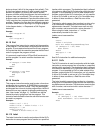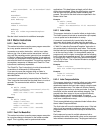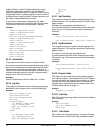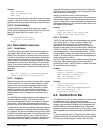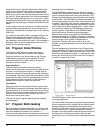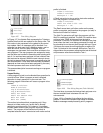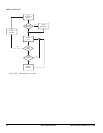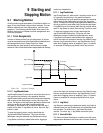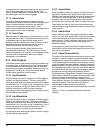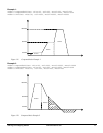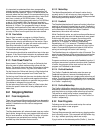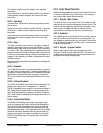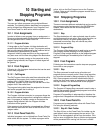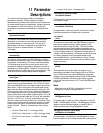
78 www.emersonct.com SM-EZMotion Module User Guide
an edge-sensitive assignment meaning that the home will
start on the rising edge of the Source signal. If the
Home.#.Initiate Destination is held active, the Home will
not initiate again until the next rising edge.
9.1.1.5 Index.#.Initiate
The Index.#.Initiate Destination is used to start the
specified index instance. When the Source assigned to the
Index.#.Initiate Destination activates, the index will
accelerate to the specified index velocity. If the
Index.#.Initiate Destination is held active, the Index will not
initiate again until the next rising edge.
9.1.1.6 Gear.Activate
Gear.Activate will, when active, cause the motor to run at
the specified Gear Ratio. The direction that the motor turns
is dependent upon the direction the master axis is
traveling, and the specified ratio. Gear.Activate is a level
sensitive assignment meaning that as long as the
Destination is active, the Gear will be active.
To stop the gearing motion, simply deactivate the
Gear.Activate Destination. The motor will ramp to zero
velocity if deceleration is enabled, or it will attempt to stop
the motor without acceleration within one update if
deceleration is not enabled.
9.1.2 From Programs
The various motion types function the same whether they
are initiated from an assignment, or from a user program.
In certain cases however, the syntax used to initiate the
motions from a program are slightly different than from an
assignment. Following is a list of instructions used to
initiate motion types from a user program.
9.1.2.1 Jog.#.PlusInitiate
Jog.#.PlusInitiate is used in a program to initiate jogging
motion in the positive direction. The user must specify
which jog is to be used in the instance location (# should be
replaced with 0 or 1 for Jog 0 or Jog 1 respectively). Since
Jog is level sensitive, the jog will remain active until a
Jog.Stop instruction is used in the same program.
If the program ends while jogging motion is active, the jog
will automatically be stopped.
9.1.2.2 Jog.#.MinusInitiate
Jog.#.MinusInitiate is used in a program to initiate jogging
motion in the negative direction. The user must specify
which jog is to be used in the instance location (# should be
replaced with 0 or 1 for Jog 0 or Jog 1 respectively). Since
Jog is level sensitive, the jog will remain active until a
Jog.Stop instruction is used in the same program.
If the program ends while jogging motion is active, the jog
will automatically be stopped.
9.1.2.3 Home.#.Initiate
Home.#.Initiate is used in a program to initiate the Home
sequence. The user must specify which Home is to be
initiated in the instance location (# should be replaced with
0 for Home 0) even though there is only one instance
available. Since Home is edge sensitive, the Home will
initiate only once until the next Home.#.Initiate instruction.
The program will wait on the Home.#.Initiate instruction
until the home is complete before moving on to the next line
of the program.
9.1.2.4 Index.#.Initiate
Index.#.Initiate is used in a program to initiate an index
profile. The user must specify which Index is to be initiated
in the instance location (# should be replaced with the
index number). If Index.#.Initiate is held active, the index
will initiate only once until the next rising edge of the
Destination signal.
The program will wait on the Index.#.Initiate instruction
momentarily until the index starts before moving on to the
next line of the program.
9.1.2.5 Index.#.CompoundInitiate
The Index.#.CompoundInitiate instruction is unique to user
programs. There is no way to compound indexes using
assignments. Compounding indexes is a way to link two or
more indexes together so that the motor does not come to
a stop in between the given indexes. Instead of stopping
between indexes, the initial index will complete its distance
at its programmed velocity. Once the initial index distance
is complete, the motor will ramp to the secondary indexes'
programmed velocity using the secondary indexes'
acceleration ramp. Regardless of whether the secondary
index velocity is less than or greater than the primary index
velocity, the ramp from the primary velocity to the
secondary velocity is the secondary indexes' acceleration.
In the program, the user can compound together as many
indexes as desired. The last index in the group of
compounded indexes should use a standard
Index.#.Initiate to signify that it should stop at the end of the
index.
Figures 111 and 112 show examples of Compound
Indexing.



